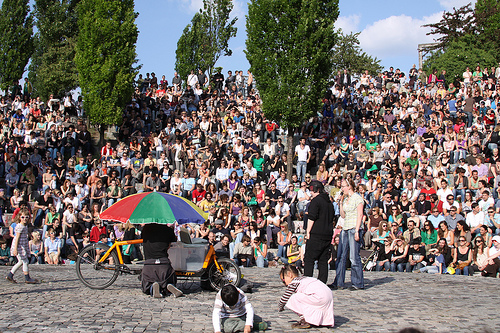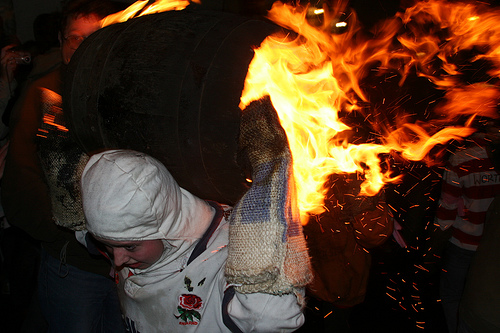 Photo: sfreimarkCross-posted from This Big City.
Photo: sfreimarkCross-posted from This Big City.
Government agencies and marketing bureaus across the globe strive to find ways to get people into parks and using public spaces. Some spend millions with extravagant firework spectaculars, while others import international music acts or host an almost continuous string of farmer’s markets and craft fairs, many of which fail to deliver a certain je ne sais quoi.
But in a not-so-pristine park in Berlin, an Irish guy named Joe draws crowds of more than 3,000 people … with karaoke. Which got me thinking, can karaoke transform our public spaces? It seems an odd thing to say, but yes, I believe it probably can.
I first learned about Joe from my trusted Lonely Planet guidebook, which told me that Bearpit Karaoke was a “must see” for a Sunday afternoon in Berlin. I arrived at Mauerpark and was amazed at the activity. A flea market was in full swing with hundreds of people buying and selling old bikes, vintage clothes, and “maker movement” crafts. People, young and old, relaxed on the unkempt grass surrounded by complimentary entertainment from skateboard tricksters, circus performers, and wannabe rock stars. In the stone amphitheatre a contortionist was pleasing a small but happy audience.
 Photo: Hsing WeiAs I sat watching and waiting it was apparent that something big was going down. Within minutes, the crowd of a hundred or so swelled to at least a thousand — families, locals, students, and tourists. In less than half an hour, it was standing room only. As the contortionist took her final bow, the crowd broke into rapturous applause as a scruffy looking guy in a checked shirt and baseball cap walked across the stage. This was it — Joe Hatchiban was here, and my opinion of karaoke was about to be changed.
Photo: Hsing WeiAs I sat watching and waiting it was apparent that something big was going down. Within minutes, the crowd of a hundred or so swelled to at least a thousand — families, locals, students, and tourists. In less than half an hour, it was standing room only. As the contortionist took her final bow, the crowd broke into rapturous applause as a scruffy looking guy in a checked shirt and baseball cap walked across the stage. This was it — Joe Hatchiban was here, and my opinion of karaoke was about to be changed.
Since the winter of 2009, Joe has been using portable, battery-powered speakers on a “hacked” cargo bike to help people unleash their inner Rampensau. Weather permitting, Joe fetches up around 3 p.m. and invites anybody who so wishes to take the stage for a few minutes to show those gathered what they can do with a backing track and a microphone. Joe has shown that with no budget, a very large serving of motivation, Facebook, and people’s desire to “get involved,” you really can transform a public space.
Bottom-up approaches are changing patterns of activity in our cities. The Australian government’s new urban design protocol, called “Creating places for people,” opens with this poignant quote from Danish architect Jan Gehl: “First life, then spaces, then buildings: the other way around never works.”
 Photo: Hans ZinsliWithout a shadow of a doubt, Ottery St Mary, a chocolate box village in rural Devon, England, puts life first. Each year on Guy Fawkes Night — a celebration commemorating the rescue of King James I from a murderous plot — locals run through the narrow streets brandishing burning barrels. Those who have visited Ottery on November 5 know that perpetuating a tradition is the objective, and commercial considerations take second place. As the Ottery Tar Barrels website says, “if you attend it, don’t try and change it, just stand back and enjoy.”
Photo: Hans ZinsliWithout a shadow of a doubt, Ottery St Mary, a chocolate box village in rural Devon, England, puts life first. Each year on Guy Fawkes Night — a celebration commemorating the rescue of King James I from a murderous plot — locals run through the narrow streets brandishing burning barrels. Those who have visited Ottery on November 5 know that perpetuating a tradition is the objective, and commercial considerations take second place. As the Ottery Tar Barrels website says, “if you attend it, don’t try and change it, just stand back and enjoy.”
I admit, when you’re there in the crowd with 20,000 others and a very large ball of fire is coming right toward you it’s hard to understand what motivates men, women, and children to carry a full-sized lighted tar barrel on their shoulders and then run down the street. But what I do know is that these brave folks are accepting complete strangers into their public space to enjoy an exhilarating and risky spectacle. Of course it’s dangerous, but good organization, cooperation between the various agencies involved, and people using good old-fashioned common sense, manage the risk.
In my hometown of Brisbane, Australia, I co-founded Lazy Sunday Cycle, a weekly all-comers fun bicycle ride. My co-founder, Amy Saunders, is passionate about encouraging interactions between people of different generations, as well as cultural and socio-economic backgrounds. Amy founded Games Night @ King George Square to help break down barriers in society. On the last Thursday of every month, in a public square in Brisbane CBD, board games can be played by anyone and with anyone.
Like Joe Hatchiban, Amy doesn’t have a big budget, but what she does have is proven knowledge that people crave interaction and a desire to be part of something fun. I guess that’s why, with the help of social media, more than 300 people attend each and every event.
If we really want public spaces to be “places,” and central parts of our towns and cities, we need to learn from people like Joe, Amy, and the Ottery barrel rollers — but most of all we need to embrace the new movement of “bottom-up self-organization.” The real reason that people turn up every week for Bearpit Karaoke isn’t because they don’t have access to iTunes. It’s because they want the buzz of being part of something fun, the supportive applause that comes from peer-to-peer performances, the serendipitous connections with people they wouldn’t normally meet. I guess that’s why karaoke really has the potential to transform our public realm.


